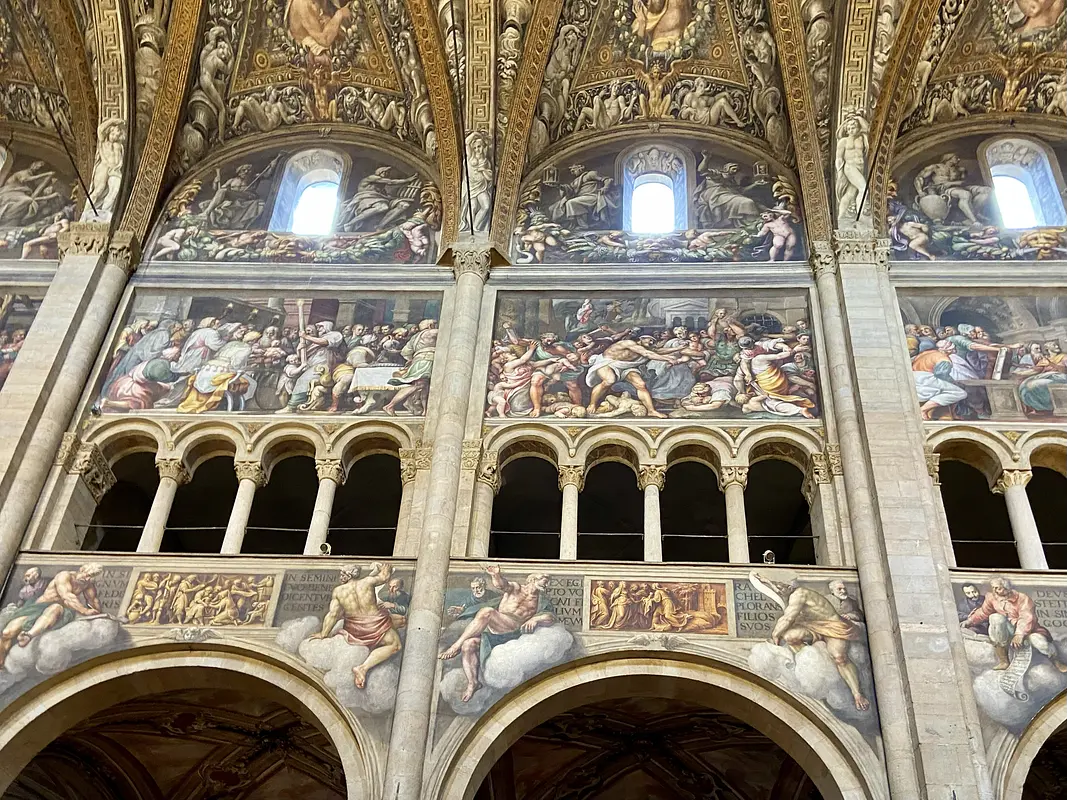





















Parma Cathedral, a triumph of frescoes
Parma Cathedral, a masterpiece of Po Valley Romanesque architecture, inside tells four centuries of history


Where

What is it and where is the Parma Cathedral
Parma Cathedral stands on the same square that is home to its bell tower, Baptistery and Episcopal Palace. Among so much beauty, the church stands out with its portals and loggias, while the bell tower at its side soars upward. The real treasure, however, lies inside. Here, the original Romanesque architecture has been covered with a 16th-century decorative apparatus, which creates a very striking environment. In particular, the counter façade and walls of the nave were frescoed by Gambara, the vault by a Parma painter.
Why it's special: the interior of Parma Cathedral, a riot of frescoes
Inside Parma Cathedral, frescoes tell centuries of history. Those found in the aisles are older than those on the counter-façade and nave: they date from the 14th and 15th centuries. Notable is the Chapel of the Commons, which tells the stories of St. Sebastian and St. Fabian in still-Gothic ways. The apse is accessed via a high marble staircase: up the steps you can see the high altar, consisting of an ark with bas-reliefs from the 12th century. Below is the crypt, with Romanesque capitals decorated with plant motifs.
Not to be missed: the Correggio dome.
Right at the intersection of nave and transept is the marvelous octagonal dome frescoed by Correggio, with the Assumption of the Virgin. Correggio is an anticipator here: while still Mannerist, he paves the way for the Baroque with his extraordinary illusionistic effects. The Virgin is in the center, flanked by Adam and Eve and St. Joseph and surrounded by a myriad of angels and saints arranged in concentric circles among fluffy clouds, and she seems to move as if propelled by the wind in a vortex that leads her to meet the waiting Christ.
"The Deposition" by Benedetto Antelami.
In the right transept we find an absolute masterpiece: a bas-relief of the Deposition, the work of Benedetto Antelami, still fully Romanesque but anticipating Gothic. In the center we see Christ on the cross, Joseph of Arimathea supporting him while Nicodemus climbs a ladder to remove the nail from his hand. On the right a woman represents the triumphant Church, followed by Our Lady, John, and the three Marys weeping for Christ; on the left an angel pushes down the head of a woman impersonating the defeated Synagogue. This is followed by Roman soldiers about to cut Christ's tunic beautifully sculpted in its sinuous folds that descend to the frame.
Fun fact: the marble floor and its fossils.
Before leaving this wonderful place a lighter notation and a small curiosity. If we look carefully at the 16th-century floor, made of beautiful red Verona marble, we will notice that it is studded with many spiral shells, some as large as 50 cm, others smaller. They are fossilized ammonites, trapped in the marble. Even Leonardo da Vinci knew them, indeed, he was the first to recognize their organic origin, and in his texts he called them "niches."
A bit of history
The church was begun around 1059 on a pre-existing early Christian basilica and was consecrated in 1106 but had to be almost rebuilt after the disastrous earthquake of 1117 that destroyed almost all the churches in the plain. In 1284 the bell tower was added, of 1187 is the work of Antelami, around 1530 Correggio frescoed the dome, of about 40 years later are the frescoes by Gambara.
Enter the Map of Italy's Undiscovered Wonders and find treasures where you least expect it... Inspire, Recommend, Share...
Contacts
The Map thanks:
In the Community
Enter the Map of Italy's Undiscovered Wonders and find treasures where you least expect it... Inspire, Recommend, Share...
Where

Contacts

